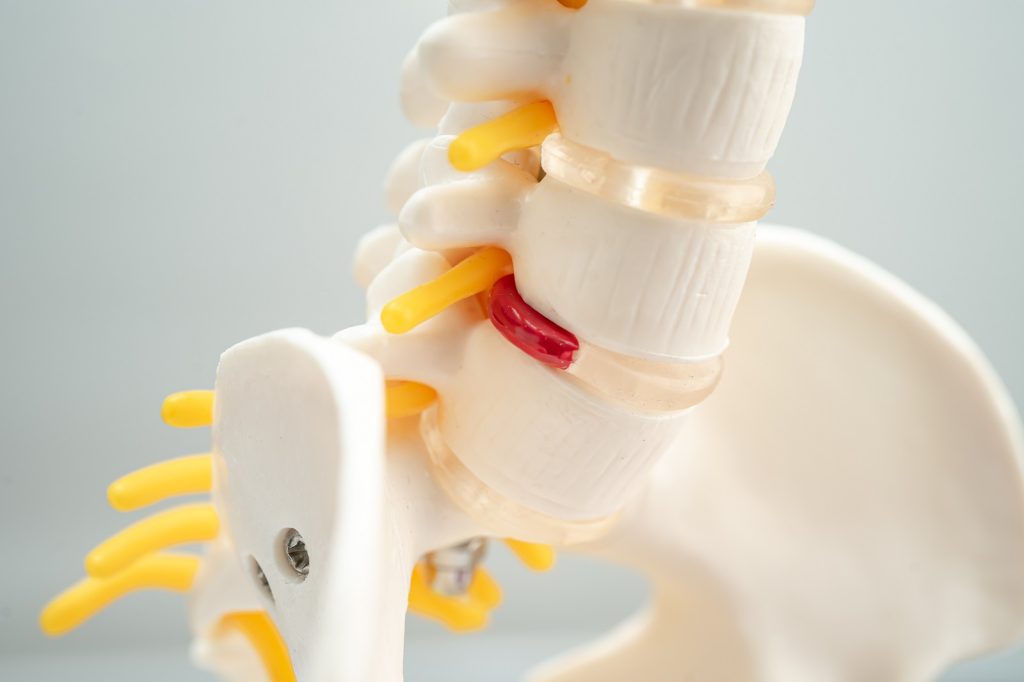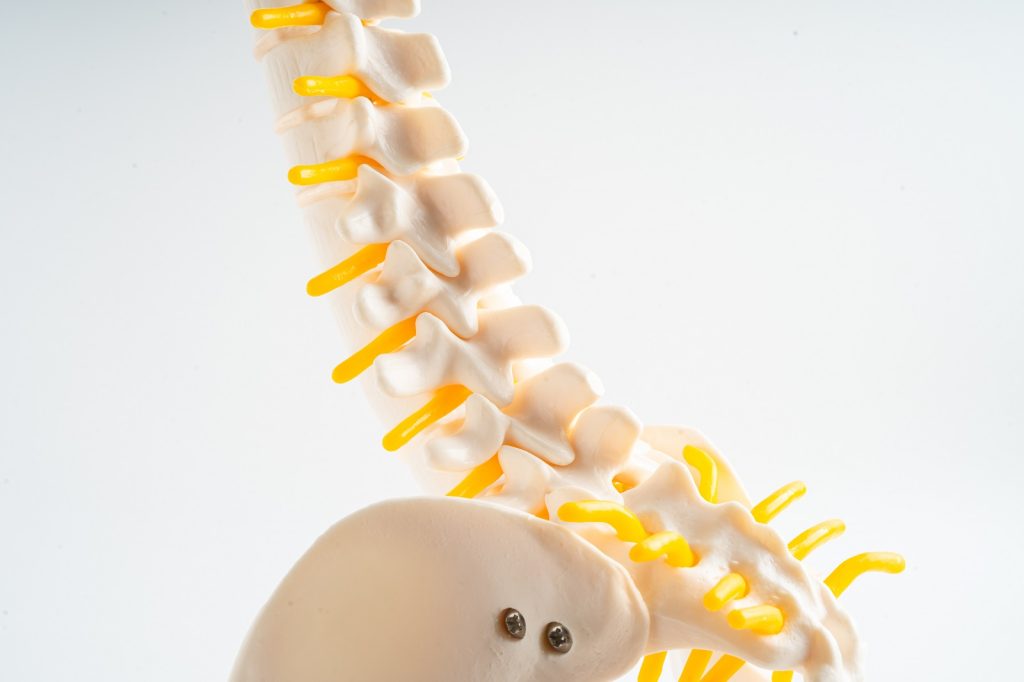Cervical Disc Bulges
A cervical disc bulge occurs when one of the discs in the cervical spine (the neck region) protrudes beyond its normal boundary. These discs are cushion-like structures between the vertebrae that absorb shock and allow for flexibility. When they bulge, they can press on nearby nerves, causing pain and other symptoms.
Causes of Cervical Disc Bulges
Cervical disc bulges can arise from a variety of factors, each contributing to the degeneration or mechanical disruption of the spinal discs. Here are the primary causes:
- Age-Related Degeneration: As individuals age, the intervertebral discs naturally lose hydration and elasticity. This desiccation results in reduced disc height and increased susceptibility to bulging due to the diminished ability to absorb spinal loads. Degenerative disc disease is a common condition among the elderly, leading to a higher incidence of disc bulges.
- Injury: Acute trauma, such as from motor vehicle accidents, falls, or high-impact sports, can cause immediate damage to the cervical discs. This can result in tears in the outer annulus fibrosus or herniation of the nucleus pulposus, leading to disc bulges. Even seemingly minor injuries can have significant cumulative effects over time.

- Repetitive Strain: Chronic repetitive motions and poor ergonomic practices, particularly in occupational settings, can exert excessive strain on the cervical spine. Activities that involve frequent bending, lifting, or prolonged periods of poor posture (such as slouching at a computer desk) can accelerate disc wear and tear, predisposing individuals to bulging discs.
- Genetics: Genetic predisposition plays a crucial role in spinal health. A family history of spinal disorders can significantly increase the likelihood of developing cervical disc bulges. Genetic factors can influence the structural integrity of the discs, making some individuals more susceptible to early degeneration and associated complications.
Understanding these causative factors is essential for both prevention and effective management of cervical disc bulges. By addressing these underlying issues through lifestyle modifications, ergonomic interventions, and appropriate medical treatments, individuals can mitigate the risks and maintain spinal health.
Symptoms of a Cervical Disc Bulge
The symptoms of a cervical disc bulge can vary widely, influenced by the severity of the bulge and the specific nerves that are affected. Common symptoms include:
- Neck Pain: This is often the most noticeable and initial symptom. It can present as a persistent dull ache or sharp, intense pain localized in the neck region.
- Radiating Pain: Pain may not be confined to the neck and can radiate down to the shoulders, arms, and even hands. This pain follows the path of the affected nerves, often described as shooting or burning.
- Numbness or Tingling: A sensation akin to pins and needles can occur in the arms or hands. This happens when the bulging disc presses on nerve roots, disrupting normal nerve function.
- Muscle Weakness: Compression of nerves can lead to muscle weakness, particularly in the arms and hands. This may manifest as difficulty in gripping objects or performing tasks that require fine motor skills, such as writing or buttoning a shirt.
Diagnosis of a Cervical Disc Bulge
Diagnosing a cervical disc bulge involves a comprehensive approach to accurately identify the issue and its impact on surrounding structures. The typical diagnostic process includes:
- Physical Examination: A thorough assessment of neck movement, muscle strength, and reflexes. This examination helps to pinpoint areas of pain, weakness, and any abnormalities in reflexes, providing initial clues about nerve involvement.
- Imaging Tests: Advanced imaging techniques like MRI (Magnetic Resonance Imaging) or CT (Computed Tomography) scans are crucial for a detailed visualization of the cervical spine. These scans can clearly show the presence, location, and extent of disc bulges, as well as any compression of spinal nerves or the spinal cord itself.
- Nerve Tests: Electromyography (EMG) and nerve conduction studies are used to evaluate the electrical activity of muscles and the conduction of nerves. These tests help to determine if there is any nerve damage or dysfunction resulting from the disc bulge.
Treatment Options for Cervical Disc Bulges
Managing a cervical disc bulge involves a range of treatment options, tailored to the severity of the condition and the specific needs of the patient. These options include:
- Conservative Methods: Initial treatments often focus on non-invasive approaches. Rest and activity modification can prevent further strain on the neck. Physical therapy is essential for strengthening the neck muscles, improving flexibility, and reducing pain. Pain management techniques, such as applying ice or heat to the affected area and taking medications like nonsteroidal anti-inflammatory drugs (NSAIDs) or muscle relaxants, can provide significant relief.
- Injections: For more persistent or severe pain, corticosteroid injections may be administered. These injections help reduce inflammation and alleviate pain by delivering anti-inflammatory medication directly to the affected area around the bulging disc.
- Chiropractic Care: Gentle spinal manipulation by a trained chiropractor can help realign the spine and relieve pressure on the nerves. Chiropractic adjustments aim to improve spinal function and reduce discomfort associated with disc bulges.
- Surgery: When conservative treatments and injections fail to provide relief, surgical intervention may be necessary. Surgical options include a discectomy, where the protruding portion of the disc is removed, or spinal fusion, which stabilizes the spine by fusing two or more vertebrae together. These procedures are considered for severe cases where there is significant nerve compression or when the disc bulge leads to neurological deficits.
Preventive Measures
To prevent cervical disc bulges:
- Maintain Good Posture: Ensure your neck and spine are properly aligned, especially when sitting for long periods.
- Exercise Regularly: Strengthen the muscles that support the spine.
- Ergonomic Adjustments: Use ergonomic furniture and adjust computer screens to eye level.
- Avoid Repetitive Strain: Take breaks and avoid activities that strain the neck.
Living with a Cervical Disc Bulge
Managing a cervical disc bulge involves lifestyle adjustments and ongoing care:
- Stay Active: Regular low-impact exercises like walking or swimming can keep your spine healthy.
- Pain Management: Follow your doctor’s recommendations for managing pain and discomfort.
- Monitor Symptoms: Keep track of any changes in symptoms and report them to your healthcare provider.

When to See a Doctor
If you experience persistent neck pain, numbness, or weakness in your arms or hands, it’s important to seek medical advice. Early diagnosis and treatment can prevent further complications and improve your quality of life.
Contact us
If you are experiencing symptoms of a cervical disc bulge and would like to explore your treatment options, we encourage you to book a consultation with Dr. Burhan. With years of expertise in spinal health and a compassionate approach to patient care, Dr. Burhan is dedicated to helping you find relief and improve your quality of life. Contact us today to schedule your appointment and take the first step towards a healthier, pain-free future.


